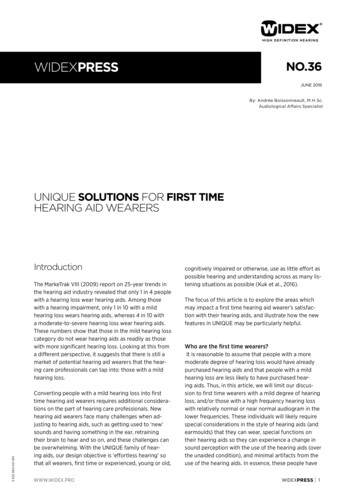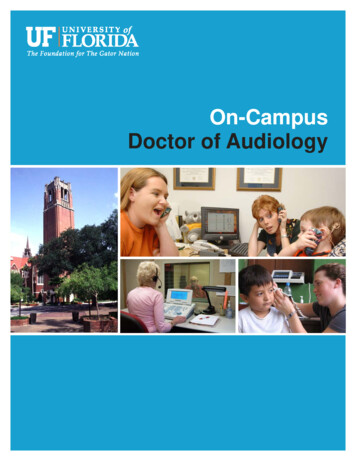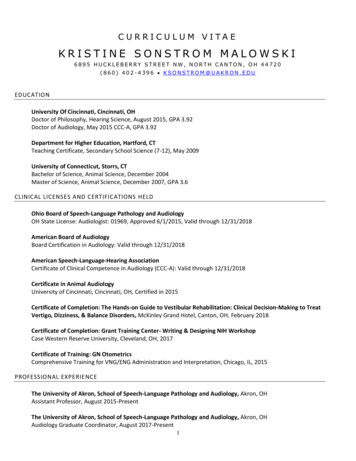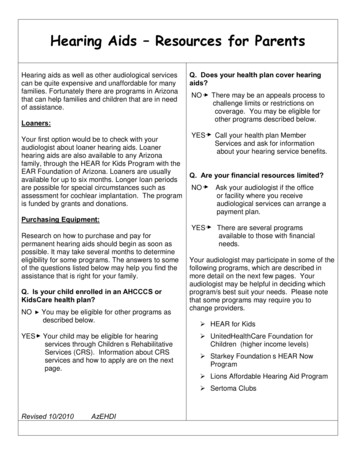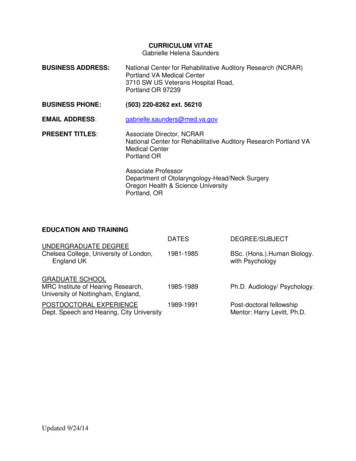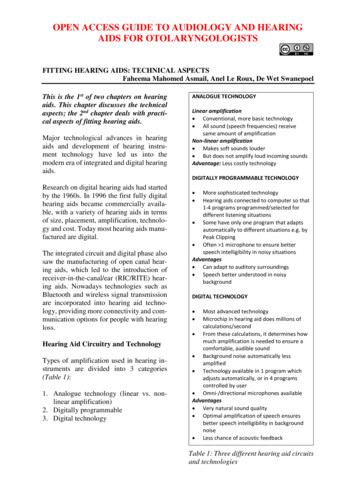
Transcription
American Academy of AudiologyChildhood Hearing Screening GuidelinesSeptember 2011The charge of the Subcommittee on Childhood Hearing Screening was to develop evidence‐basedrecommendations for screening hearing of children age 6 months through high school.Committee members and contributorsChair: Karen L. Anderson, PhD, Karen L. Anderson Audiology Consulting, Minneapolis, MNMembers: Candi Bown; Nebo School District, Springville UT; Melissa R. Cohen, AuD., Cobb CountyPublic Schools, Atlanta GA; Susan Dilmuth‐Miller, AuD., East Stroudsburg University, East Stroudsburg,PA; Donna Fisher Smiley, PhD, Arkansas Children’s Hospital, Little Rock, AR; Debra Gwinner, AuD. CherryCreek Schools, Greenwood Village, CO; Barbara Lambright, AuD, Cherry Creek Schools, GreenwoodVillage, CO; Barb Norris, Ed.D, Consultant; Erin Plyler, AuD., University of Tennessee Health ScienceCenter, Knoxville, TN; Aparna Rao, PhD, University of Minnesota, Minneapolis, MN; Jane Seaton, MS.,Seaton Consultants, Athens, GA; Victoria Walkup‐Pierce, AuD, Orange County Public Schools, Orlando,FL;Contributors: Kathryn Bright, PhD., University of Northern Colorado, Greeley, CO; John Eichwald, MS;CDC/EHDI, Atlanta, GA; Jay Hall III, PhD, University of Florida, Gainesville FL; Wendy D. Hanks, Ph.D.,Gallaudet University, Washington DC; Brad Ingrao, AuD., Sound Advice Hearing Solutions; Pat Mauceri,AuD., Northeastern University in Boston, MA Kimberly Miller, AuD., Thompson R2‐J School District,Loveland, CO; Gail Tanner, Au.D., Illinois Department of Public Health;EXECUTIVE SUMMARYThe American Academy of Audiology endorses detection of hearing loss in early childhood andschool‐aged populations using evidence‐based hearing screening methods. Hearing loss is the mostcommon developmental disorder identifiable at birth and its prevalence increases throughout school‐age due to the additions of late‐onset, late identified and acquired hearing loss. Under identificationand lack of appropriate management of hearing loss in children has broad economic effects as well as apotential impact on individual child educational, cognitive and social development. The goal of earlydetection of new hearing loss is to maximize perception of speech and the resulting attainment oflinguistic‐based skills. Identification of new or emerging hearing loss in one or both ears followed byappropriate referral for diagnosis and treatment are first steps to minimizing these effects. Informingeducational staff, monitoring chronic or fluctuating hearing loss, and providing education toward theprevention of hearing loss are important steps that are needed to follow mass screening if the impact ofhearing loss is to be minimized.1
Summary of Hearing Screening Recommendations** Refer to the full Guidelines document for more detail on these recommendations. Note thatthe following guidelines are considered to be the minimum standard for educational settings.Programs are encouraged to follow a more intensive rescreening and referral protocol where staffingpatterns permit.Pure tone screening1. Perform biological check on pure tone screening equipment prior to daily screening.2. Screen populations age 3 (chronologically and developmentally) and older using pure tonescreening.3. Perform a pure tone sweep at 1000, 2000, and 4000 Hz at 20 dB HL.4. Present a tone more than once but no more than 4 times if a child fails to respond.5.Only screen in an acoustically appropriate screening environment.6. Lack of response at any frequency in either ear constitutes a failure.7. Rescreen immediately.8. Use tympanometry in conjunction with pure tone screening in young child populations (i.e.,preschool, kindergarten, grade 1).9. Screen for high frequency hearing loss where efforts to provide education on hearing lossprevention exist.10. Minimum grades to be screened: preschool, kindergarten, and grades 1, 3, 5 and either 7 or 9.Tympanometry screening1. Calibrate tympanometry equipment daily.2. Tympanometry should be used as a second‐stage screening method following failure of puretone or otoacoustic emissions screening.3. Use defined tympanometry screening and referral criteria: a 250 daPa tympanometric width isthe recommended criterion. If it is not possible to use tympanometric width then 0.2 mmhosstatic compliance can be used as the criterion. A final choice for failure criterion is negativepressure of ‐200 daPa to ‐400 daPa however it is not appropriate for this criterion to standalone to elicit a referral.4. Young child populations should be targeted for tympanometry screening.5. Use results of pure tone or OAE and tympanometry rescreening to inform next steps.Rescreening1. Rescreen with tympanometry after a defined period: after failing the immediate pure tonerescreening and in 8‐10 weeks for children failing pure tone or OAE screening andtympanometry.2. Do not wait to perform a second stage screening on children who fail pure tone screening only.2
OAE1. Use only for preschool and school age children for whom pure tone screening is notdevelopmentally appropriate (ability levels 3 years).2. Calibrate OAE equipment daily.3. Maintain primary DPOAE levels at 65/55 dB SPL.4. Select DPOAE or TEOAE cut‐off values carefully.5. Default settings may not be appropriate.6. Screening programs using OAE technology must involve an experienced audiologist.7. Children failing OAE should be screened with tympanometry.Acoustic reflex testing, reflectometry and hearing screening using speech materials are notrecommended.3
TABLE OF CONTENTSI. INTRODUCTIONa. Background and philosophyb. Prevalence of childhood hearing lossc. Economic impact of hearing lossd. Educational impact of hearing lossi. Definition of normal hearingii. Minimal sensorineural hearing lossiii. Unilateral hearing lossiv. High frequency hearing lossv. Hearing loss due to otitis media with effusione. Population of children to be screenedi. Early childhoodii. Preschooliii. School‐agediv. Targeted grade levelsII. METHODOLOGYa. Evidenced based reviewb. Sensitivity and Specificityc. British National Institute for Health Research Assessment d. Test Procedure and Protocol reviewi. Pure tone screening1. Intensity2. Frequency3. Number of presentations4. Screening environmentii. Immittance1. Tympanometrya. Middle ear pressureb. Tympanometric widthc. Static admittance (compliance)2. Acoustic reflex and reflectometryiii. Screening with speech stimuli materialsiv. Otoacoustic emissions1. Measurement parameters2. Screening considerations: environment and time3. Transient‐evoked OAEs4. Distortion‐product OAEs5. Research summary6. OAE limitations7. OAE Future needsv. RescreeningIII. DISCUSSION/RESULTS/RECOMMENDATIONSa. Protocol recommendationsi. Pure tone screeningii. Immittance1. Tympanometry2. Acoustic reflex and reflectometry4
iii. Screening with Speech Stimuli Materialsiv. Otoacoustic Emissionsv. Rescreeningb. Referral and follow‐upc. Program managementi. Personnel and staff trainingii. Schedulingiii. Equipment selection1. Pure tone screening equipment2. Immittance screening equipment3. Otoacoustic emissions screening equipmentiv. Equipment maintenancev. Infection controlvi. Accountabilityvii. EvaluationIV. CONCLUSION/SUMMARYV. REFERENCESVI. APPENDICES5
American Academy of AudiologyChildhood Hearing Screening GuidelinesINTRODUCTIONBackground and PhilosophyHearing loss is the most prevalent developmental abnormality present at birth (White, 1997).Identification of hearing loss by 6 months of age in combination with quality early intervention servicesis associated with language development at or near the typical rate of development (Yoshinaga‐Itano,1995; Yoshinaga‐Itano, 1998; Yoshinaga‐Itano, et al. 2000; Yoshinaga‐Itano, et al. 2004). Age‐appropriate language development and literacy outcomes require early and ongoing attention to skilldevelopment, and for the effects of hearing loss on skill development and socialization to be prevented,it first is necessary for childhood hearing loss to be identified. This document provides a review of thecurrent “state of the art” in pediatric hearing screening and recommends evidenced‐based protocols forthe identification of hearing loss in the preschool and school‐aged population.Need for hearing screening guidelinesThe presumption that hearing loss can be reliably identified based on a child’s behavior ineveryday situations has been shown to be faulty by several studies documenting outcomes from the useof parent questionnaires (Olusanya, 2001; Gomes and Lichtig 2005; Lo et al. 2006). The Joint Committeeon Infant Hearing (2007) identified ten risk factors for delayed onset or progressive hearing loss inchildren. Evidence suggests that for 9‐year‐olds with educationally significant hearing loss, up to 50%will have passed newborn hearing screening (Fortnum et al. 2001). Finally, it is estimated that 9‐10 per1000 children will have identifiable permanent hearing loss in one or both ears by school‐age(Sharagorodsky, Curhan, Curhan and Eavey, 2010; White, 2010).The American Academy of Pediatrics (AAP) endorses hearing screening throughout infancy, earlychildhood, middle childhood and adolescence in its Recommendations for Preventive Pediatric HealthCare (American Academy of Pediatrics 2007). All newborns are to be screened in accordance with theJoint Committee on Infant Hearing (JCIH) Year 2007 Position Statement with additional hearingscreening to be performed during routine well child visits at ages 4, 5, 6, 8, and 10. Well‐child care playsan important role in the provision of quality health care for children; however, many children have farfewer well‐child visits than are recommended by the AAP (Selden 2006). Even when a child is seen for awell‐child visit, pediatricians typically neither recheck hearing nor refer more than half of the tenpercent of children who fail their hearing screening (Halloran et al. 2006).6
It is the position of the American Academy of Audiology (AAA) that children with undetectedhearing loss and/or persistent or recurrent middle ear disease be identified so that appropriateaudiologic and medical management can be provided (AAA, 1997). The American Speech‐Language‐Hearing Association (ASHA) Guidelines for Audiologic Screening endorses the identification of schoolchildren at risk for hearing impairment that may adversely affect education, health, development orcommunication as an expected outcome for hearing screening programs (ASHA, 1997).Finally, the criteria for appraising the viability, necessity, effectiveness and appropriateness ofscreening programs are based on ten principles from the World Health Organization that serve as thebasis for recommending or planning screening for early detection of significant health conditions.(Wilson & Jungner, 1968) (See Table 1). Hearing loss and its potential consequences unquestionablymeet these criteria to qualify as a health condition that merits screening.Table 1. Ten principles for appraising the appropriateness of screening programs1.The condition sought should be an important health problem.2.There should be an accepted treatment for patients with recognized disease.3.Facilities for diagnosis and treatment should be available.4.There should be a recognizable latent or early symptomatic stage.5.There should be a suitable test or examination.6.The test should be acceptable to the population.7.The natural history of the condition, including development from latent to declareddisease, should be adequately understood.8.There should be an agreed policy on whom to treat as patients.9.The cost of case‐finding (including diagnosis and treatment of patients diagnosed) shouldbe economically balanced in relation to possible expenditure on medical care as a whole.10.Case findings should be a continuing process and not a “once and for all” project.Table 1: World Health Organization Screening Principles (developed by Wilson & Jungner, 1968)Prevalence of Hearing Loss in ChildrenThe prevalence of congenital hearing loss in newborns has long been thought to range from 1 toover 3 infants per 1,000, or approximately 13,000 babies born in the United States each year with somedegree of permanent hearing loss (Finitzo et al. 1998; Van Naarden et al. 1999). ). Most recentinformation indicates that the current prevalence is 1.4 per 1,000 (US Centers for Disease Control andPrevention 2009). Early Hearing Detection and Intervention (EHDI) programs have become the standardof care in this country, and screening for hearing loss now occurs for more than 95% of infants born inthe United States. Diagnostic findings for 43.3% of infants identified by hearing screening were reported7
as unknown due to lack of documentation at a state level, and more than one quarter (28.1%) of infantswho were identified as having confirmed hearing loss could not be documented as receivingintervention services (US Centers for Disease Control and Prevention 2008). Not all cases of hearing lossin early childhood are identified through EHDI programs due to the following factors: 1) universalnewborn hearing screening (UNHS) programs utilize screening devices primarily designed to targethearing loss averaging 30 to 40 dB or more; 2) all infants not passing their newborn hearing screening donot receive needed diagnostic services; and 3) UNHS does not identify late onset, acquired, or manycases of progressive loss (Joint Committee on Infant Hearing, 2007).Grote (2000) reported that neonatal hearing screening programs would not detect the 10 to 20percent of cases of permanent childhood hearing loss that start later in life. Prevalence comparisonssuggest a significantly higher prevalence of hearing loss in the school age population relative to theprevalence identified in the newborn period. Prevalence studies in the United Kingdom indicated thatfor every 10 children with permanent bilateral hearing impairment of greater than 40 dB HL detected byuniversal newborn hearing screening, another 5 to 9 children would manifest such a hearing impairmentby the age of 9 years (Fortnum et al. 2001). Analysis of school hearing screening results from almost100,000 students revealed that 2.9% required management such as advice to parents, referral toeducation services, watchful waiting, medical and surgical treatment, and amplification, and of thechildren screened, 2.2% were newly identified as hearing impaired (Fonseca et al. 2005).The United States Centers for Disease Control and Prevention (CDC) has had the legislativeauthority to conduct the National Health and Nutrition Examination Survey since 1970 to providecurrent statistical data on the amount, distribution, and effects of illness and disability in the UnitedStates (CDC 2010). Three surveys have been conducted: NHANES I from 1971‐1975; NHANES II from1976‐1980; and NHANES III from 1994‐1998. NHANES data have been collected annually since 1999.Each of these surveys reported pure tone average air conduction results for (500, 1000, 2000, and 4000Hz) of more than 5000 school‐aged children. NHANES III data suggest 14.9% of school‐aged children inthe United States (more than 7 million children in the 6 to 19 year age range) have some degree ofhearing loss (Niskar et al., 1998). It should be noted that NHANES findings do not separate temporaryfrom permanent hearing loss. The success of EHDI programs is likely to reduce the number of new casesof permanent hearing loss identified in school‐based hearing screening programs However, theimportance of identifying late onset, acquired, and progressive hearing loss, as well as cases ofcongenital losses not identified through newborn hearing screening, underscores the need foridentification practices beyond the newborn period to ensure the provision of timely interventionservices and reduce or minimize educational and behavioral sequelae for all preschool and school‐agedchildren and youth with hearing loss.In summary, it has been estimated that the 3/1000 prevalence of permanent hearing loss ininfants can be expected to increase to 9‐10/1000 children in the school‐age population (White, 2010)8
and permanent and/or transient hearing loss in one or both ears affects more than 14% (one in seven)of school‐aged children. As a result, several students in every classroom potentially will have difficultiesperceiving speech clearly in the educational environment. Hearing loss can contribute to difficulties withattention, learning, and social function. The prevalence of hearing loss in children is great enough toaffect individual and standardized school test scores if these students are not identified and providedthe medical and/or educational assistance needed (Sarff, Ray, & Bagwell, 1981; Ray, 1992).Economic Impact of Hearing LossOne of the accepted principles of screening is that it should be economically balanced in relationto possible expenditures of resources. The costs of rehabilitation, special education, and under‐ and un‐employment due to disorders of hearing, voice, speech, and language have been projected as 154‐186billion, approximately 3% of the gross national product of the USA in 1999 (Ruben, 2000). RTIInternational (Research Triangle Park, North Carolina) and the CDC analyzed data from multiple surveysand reported estimates for the direct and indirect economic costs associated with hearing loss, as wellas other developmental disabilities in the United States (CDC, 2004‐06.). Their estimated lifetime costs(in 2003 dollars) were 383,000 for each person with hearing loss, totaling a projected 1.9 billion for allpersons with hearing loss. Total direct costs (i.e., direct medical plus direct nonmedical) amounted toapproximately 601 million. Economic cost estimates clearly do not reflect the impact of hearing loss onintangibles that cannot be directly measured (e.g., quality of life).The retention rate (repeating a grade) among students with unilateral hearing loss (UHL) hasbeen estimated at 30% (Bess & Tharpe, 1986; Oyler, Oyler, & Matkin, 1986) and slightly higher, 37%,among their subjects with minimal sensorineural hearing loss (MSHL) (Bess, Dodd‐Murphy, & Parker,1998). The cost of retaining a student is an economic burden to the educational system. For 56 millionschool‐aged children in the United States (United States Department of Education, 2006), slightly over 3million (5.4%) will have MSHL, and 37% (approximately 1 million) can be projected to repeat a grade.With an average cost of 9,200 to educate a child for one year (United States Department of Education,2006), the total expenditure for a repeated grade is in excess of 10 billion dollars.The present calculated lifetime educational cost of hearing loss (greater than 40 dB permanentloss without other disabilities) is 115,600 per child and the identification, diagnosis and intervention forinfants with permanent hearing loss resulting from newborn hearing screening reduces specialeducation costs by an estimated 36% or a reduction of 44,200 per child (Grosse, 2007). This assumesthat children who are deaf or hard of hearing receive 12 years of special education, that all children withhearing loss are diagnosed as a result of newborn screening and receive intervention services by 6months of age, and that children who have multiple disabilities will have similar reductions in educationcosts as those with isolated hearing losses. These economic figures also suggest that school districts9
spend 2.4 times more on average for each student enrolled in a program for the deaf and hard ofhearing than for a child who does not receive special education services.Historically, unidentified childhood hearing loss has affected educational achievement, limitedchoices for higher education and ultimately decreased vocational options (Holden‐Pitt & Diaz, 1998).Holt, Traxler and Allen (1997) found that children who are deaf attained median reading scores at the4.0 grade level by the age of 17 or 18 years. This information predates the impact of early identificationof hearing loss secondary to universal newborn hearing screening. Of students who are deaf or hard ofhearing who are accepted into higher education, 70% withdraw from college before earning a collegedegree (Stinson & Walter, 1992). Data from the 2000 U.S. census indicate the total unemployment ratefor 16‐64 years is 60% for persons with severe sensory disabilities, and less than one‐third of adults whoare deaf and under the age of 35 who want to work can find a job. Wages earned by males who are deafare 77% of the national wage average, whereas the wages earned by females who are deaf are 88% ofthe national wage average within every occupational grouping (US Department of Labor, 1990).In summary, even with a high school diploma, an individual with late‐identified hearing loss islikely to have poorer language and reading achievement, be less competitive with other high schoolgraduates for jobs, and is less likely to attain a college degree. Moreover, the jobs that are held bypersons who are deaf often carry a reduced salary. Similar data do not exist for individuals who are hardof hearing and late identified; however, they are at high risk for delayed language, educationalchallenges and underemployment, although they typically would be affected to a lesser degree thanindividuals who are deaf. The greater costs to society due to late identified congenital hearing lossinclude expensive special education services, a less productive subgroup of the work force resulting infewer dollars in lifetime tax contributions, and the individual costs that are both monetary and personal.If early identification of childhood hearing loss and provision of appropriate high quality earlyintervention services result in improved language abilities, lower educational and vocational costs, andincreased lifetime productivity, then long‐term cost savings can be predicted (Keren, Helfand, Homer,McPhillips, & Lieu, 2002).Educational Impact of Hearing LossThe typical classroom is an auditory verbal environment where accurate transmission andreception of speech between teachers and students, and from student to student, is critical for effectivelearning to occur (Smaldino & Flexer, 2008). Hearing loss, whether consistent or fluctuating, interfereswith the accurate reception of speech, especially under noisy and reverberant classroom conditions andwhen speech is presented at a distance from the student (Blumsack & Anderson, 2004). The behavioraleffects of hearing loss are often subtle and resemble effects similar to those of children who experienceattention deficit disorders, learning disabilities, language processing problems or cognitive delays.Examples of commonly cited behaviors include the following (Johnson & Seaton, 2011):10
1. Has difficulty attending to spoken or other auditory information.2. Frequently requests repetition.3. Fatigues easily when listening.4. Gives inappropriate answers to simple questions.5. Appears isolated from peers.6. Has difficulty with reading skills.7. Has difficulty with spoken and/or written language.8. Is easily frustrated.In a survey of parents of children with identified hearing loss, 3 out of 4 responding parentsreported their children had experienced problems due to hearing loss (Kochkin et al. 2007). The mostserious problems were noted to occur in the areas identified in Table 2.Percent of reporting parentsTable 2. Percent of parents of children with hearing loss reporting problems related to the hearing loss.Definition of normal hearingBecause this document focuses on screening for educationally significant hearing loss, it isimportant to consider the criterion for “normal.” The American Academy of Ophthalmology andOtolaryngology (AAOO, 1965) established 26 dB as an allowable limit of hearing damage with reference11
to worker’s compensation regarding earning power. These guidelines were revised in 1973 and 1979(Moller, 2006). In the context of vocational performance, 26 dB was set as an “acceptable hearing loss”because this was the hearing level at which an individual begins to experience difficulty understandingeveryday speech in a quiet environment. The AAOO guidelines state the ability to understand normaleveryday speech at a distance of about 5 feet does not noticeably deteriorate as long as the hearing lossdoes not exceed an average value of 25 dB at 500, 1000 and 2000 Hz. This amount of hearing loss wasregarded as a “just noticeable” handicap for which a worker in the United States was entitled to receiveworkmen’s compensation for loss of earning power. The American Academy of Otolaryngology has notupdated these early recommendations by the AAOO. Although the American Medical Associationreleased the 6th edition of the Guides to the Evaluation of Permanent Impairment in 2007, they followthe AAO 1979 guidelines in their use of 26 dB as the demarcation for hearing loss.Bavosi and Rupp (1984) described the use of 26 dB as a cut‐off between normal and mildhearing loss as antiquated because this approach may cause individuals to conclude that no hearingproblem exists below this cut‐off intensity level. As reported earlier, more than 7 million children from 6to 19 years of age (14.9% of school aged children in the United States) have some degree of hearing loss(Niskar et al., 1998). Even though the majority of hearing loss in this report was identified as unilateraland of minimal degree, evidence suggests these hearing deficits can adversely affect a child’sdevelopment, overall well‐being, or both (Ross et al., 2008). According to Frankenberg (1971), theoutcomes of screening include identification as early as possible of those individuals who have a defineddisorder, those who would otherwise have not been identified, and those for whom treatment willameliorate the effects of the disorder. The foremost purpose in any hearing‐screening program is toidentify the children in the population who have hearing deficits that could adversely impact theireducation and who would not otherwise be identified. The linguistic and educational impact of minimalhearing loss is further described in the sections that follow.Minimal Sensorineural Hearing LossBeginning in the mid‐1980s research began to focus on milder degrees of hearing loss. The termminimal sensorineural hearing loss (MSHL) was used to include three different hearing loss categories:bilateral sensorineural hearing loss (average air conduction thresholds between 20 and 40 dB in bothears), high‐frequency sensorineural hearing loss (mean air conduction thresholds 25 dB at two or morefrequencies above 2 kHz in one or both ears), and unilateral sensorineural hearing loss (mean airconduction thresholds 20 dB in the impaired ear) (Bess, 1982; Bess & Tharpe, 1984; Bess & Tharpe,1986; Culbertson & Gilbert, 1986; Klee & Davis‐Dansky, 1986). A 5.4% prevalence of MSHL in a group of3rd, 6th, and 9th grade children was reported by Bess, Dodd‐Murphy, & Parker (1998), and they foundlower educational test performance for 3rd grade children with MSHL compared with typical hearingpeers and greater dysfunction in areas such as behavior, energy, stress, social support and self‐esteem12
for sixth and ninth grade children with MSHL. Additional studies report children with this MSHL are athigher risk for academic struggles (37% repeating a grade), speech‐language deficits (4.3 times morelikely to experience trouble in communication) and social‐emotional difficulties (poorer self esteem andless energy) (Tharpe & Bess, 1991; Bess et al., 1998; Bess, 1999; McKay, Gravel & Tharpe, 2008).Unilateral Hearing LossBess (1982) and his colleagues (Bess & Tharpe, 1984; Bess & Tharpe, 1986; Culbertson & Gilbert,1986; Klee & Davis‐Dansky, 1986) also highlighted the significance of unilateral hearing loss (UHL) andclassroom challenges related to hearing loss of greater than 20 dB in one ear. Although differences inlanguage skills and intelligence were not found between those with UHL and normal‐hearing children, aslightly higher incidence of behavior problems was noted for the group with UHL. In addition, 37% of thechildren with UHL were found to have repeated a grade.High Frequency Hearing LossBlair et al (1996) reported that 97% of 273 third graders surveyed had been exposed tohazardous sound levels, and Chermak and Peters‐McCarthy (1991) found that 43% of elementarystudents routinely listen to a personal stereo or TV at a loud volume). Evidence of increased prevalenceof hearing loss in students was obtained by Montgomery & Fujikawa (1992) who found that over a ten‐year period, 2nd graders with hearing loss increased 2.8 times, and hearing loss in 8th graders hadincreased 4 times. Cone, Wake, Tobin, Poulakis, and Rickards (2010) reported the association betweenslight‐mild sensorineural hearing loss and parent report of personal stereo use.Using data from the third National Health and Nutrition Examination Survey (NHANES III), Niskaret al. (1998) reported a low frequency hearing loss (LFHL) prevalence of 7.6% for 6‐11 year old studentsand 6.6% for the 12‐19 year age group. High frequency hearing loss (HFHL) prevalence was 12.2% for 6‐11 year olds and 13.0% for the older group. The degree of high frequency hearing loss reported in thesestudies is generally mild in nature and sometimes not even noticed by the children themselves. Theprevalence of high frequency hearing loss was highest in the poorer ear at 6000 Hz (24.7%) and 8000 Hz(27.3%). NHANES III data also suggest that 14.9% of school‐aged children in the United States have somedegree of hearing loss (Niskar et al. 1998). Differences between the NHANES III and NHANES 2005‐2006data were recently analyzed, and the more recent data suggest an overall hearing loss prevalenceincrease from 14.9% to 19.5% (Shargorodsky, Curhan, Curhan, & Eavey, 2010),. More detailed analysisindicated 1 in 5 adolescents in the United States 12 to 19 years of age demonstrated hearing loss (mostcommonly unilateral (14%) and involving high frequencies
The American Academy of Pediatrics (AAP) endorses hearing screening throughout infancy, early childhood, middle childhood and adolescence in its Recommendations for Preventive Pediatric Health Care (American Academy of Pediatrics 2007). All newborns are to be screened in accordance with the

